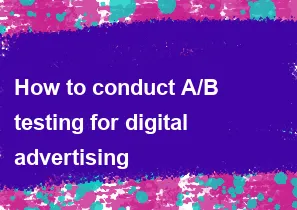How to conduct A/B testing for digital advertising

A/B testing, also known as split testing, is a method used to compare two versions of a webpage, email campaign, or in this case, digital advertising, to determine which performs better. Here's a step-by-step guide on how to conduct A/B testing for digital advertising:
Define Your Objective: Clearly define the goal of your A/B test. Whether it's increasing click-through rates, improving conversion rates, or boosting engagement, having a clear objective will guide your test design.
Choose a Variable to Test (A/B Element): Identify the specific element of your digital ad that you want to test. This could be the ad copy, headline, images, call-to-action, colors, or any other creative or targeting element.
Create Two Versions (A and B): Develop two distinct versions of your digital ad, keeping everything else constant except for the variable you're testing. Version A is your control group, and version B is your experimental group.
Randomized Assignment: Randomly assign each version to different segments of your target audience. This helps ensure that any differences in performance are not due to audience biases.
Implement Tracking: Set up tracking mechanisms to measure the performance of each version. This may involve using analytics tools, ad platforms, or custom tracking parameters to monitor key metrics such as click-through rates, conversion rates, and other relevant KPIs.
Run the Test Simultaneously: To minimize external factors that could skew results, run both versions of the ad simultaneously. This helps account for variations in audience behavior due to time-of-day or day-of-week effects.
Collect and Analyze Data: Monitor the performance metrics closely during the testing period. After sufficient data has been collected, perform statistical analysis to determine if there's a significant difference between the two versions.
Draw Conclusions: Based on the data analysis, draw conclusions about which version performed better in achieving your defined objective. If one version significantly outperforms the other, you can implement the changes permanently.
Scale and Iterate: Implement the winning version on a larger scale if it improves performance. Additionally, use the insights gained to inform future iterations and A/B tests to continuously optimize your digital advertising strategy.
Document and Share Results: Document the results of your A/B test, including key findings, insights, and any actionable takeaways. Share these results with relevant stakeholders to inform future marketing strategies.
Remember, A/B testing is an iterative process, and ongoing testing can help refine and optimize your digital advertising efforts over time.
-
Popular Post
- How to optimize for Google's About This Result feature for local businesses
- How to implement multi-language support in an Express.js application
- How to handle and optimize for changes in mobile search behavior
- How to handle CORS in a Node.js application
- How to use Vue.js with a UI framework (e.g., Vuetify, Element UI)
- How to configure Laravel Telescope for monitoring and profiling API requests
- How to create a command-line tool using the Commander.js library in Node.js
- How to implement code splitting in a React.js application
- How to use the AWS SDK for Node.js to interact with various AWS services
- How to use the Node.js Stream API for efficient data processing
- How to implement a cookie parser middleware in Node.js
- How to implement WebSockets for real-time communication in React
-
Latest Post
- How to implement a dynamic form with dynamic field styling based on user input in Next.js
- How to create a custom hook for handling user interactions with the browser's device motion in Next.js
- How to create a custom hook for handling user interactions with the browser's battery status in Next.js
- How to implement a dynamic form with dynamic field visibility based on user input in Next.js
- How to implement a dynamic form with real-time collaboration features in Next.js
- How to create a custom hook for handling user interactions with the browser's media devices in Next.js
- How to use the useSWRInfinite hook for paginating data with a custom loading indicator in Next.js
- How to create a custom hook for handling user interactions with the browser's network status in Next.js
- How to create a custom hook for handling user interactions with the browser's location in Next.js
- How to implement a dynamic form with multi-language support in Next.js
- How to create a custom hook for handling user interactions with the browser's ambient light sensor in Next.js
- How to use the useHover hook for creating interactive image zoom effects in Next.js